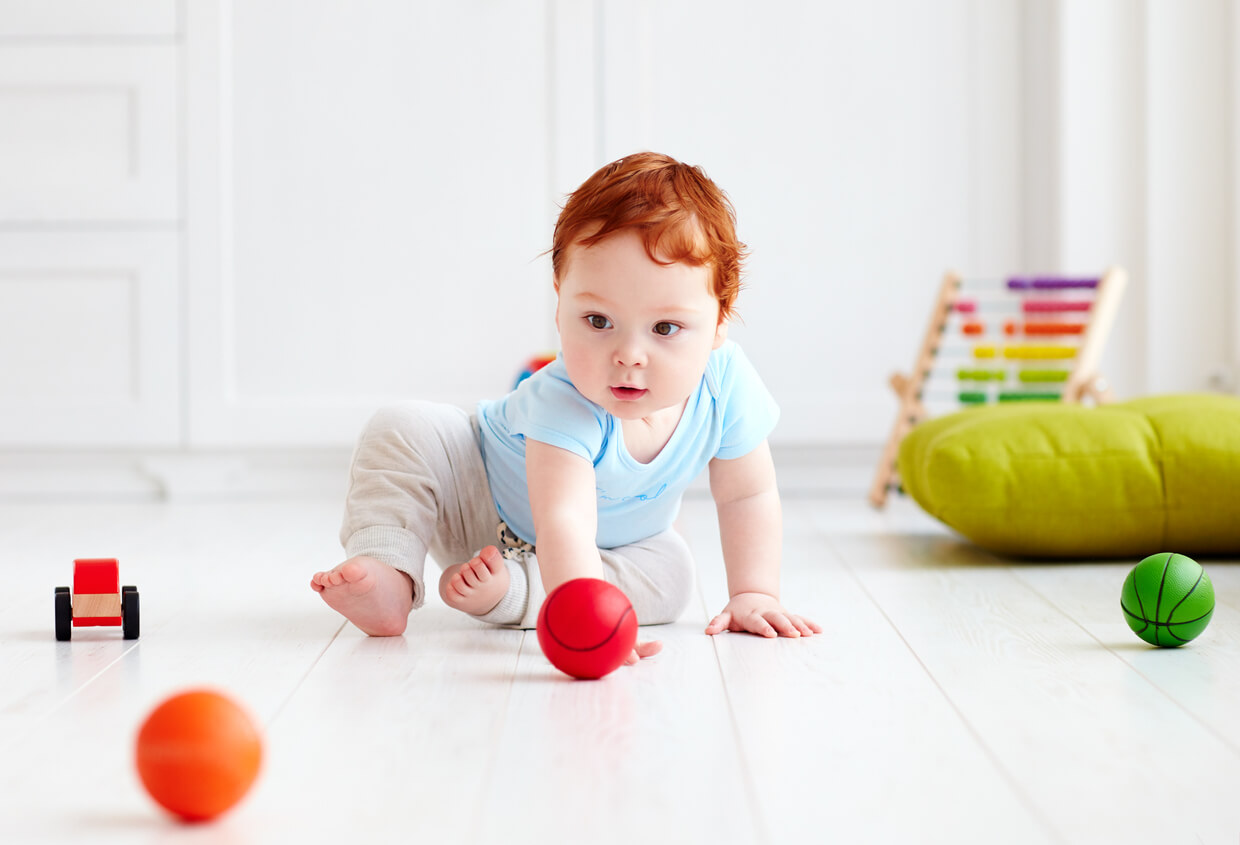7 Ball Games for Children


Written and verified by degree in physical education and sports Andrés Felipe Cardona Lenis
Have you ever thought about all the benefits of ball games for kids? Possibly yes, but today we’re going to share with you some others that you can’t even imagine.
Balls are a constant in several human disciplines: Sports, teaching, and also health. With this in mind, children’s play is no exception. In fact, these elements capture the attention of little ones in a special way and represent fun and enjoyment for them.
Taking advantage of this great advantage, we’ll show you some ball games for children that are perfect for playful, educational, and recreational purposes.
Ball games stimulate different physical abilities
In addition to being fun, ball games favor the development of different physical abilities in children.
There are several types of balls, depending on the sport or activity to be performed. But all of them can be used to play. It’s best to familiarize the child with the element before starting the activity. Then, explain the necessary guidelines to put it into practice.
Here are 7 alternatives to take advantage of this simple and wonderful object. Take note!
1. Visual coordination game

Visual-motor coordination is the simultaneous use of the eyes and a body segment, such as the hands. To achieve it, a high degree of precision is required.
While they’re developing this ability, children need to concentrate to perform the activity. Later, they’ll do it more automatically.
To work on this skill, we recommend a fun activity that can be achieved with very few elements. All you need is a ball, a rope, and a child who wants to play. We’ll explain it below:
- Tie the ball to the rope and stand to one side of the child.
- Take the rope and start moving the ball as if it were a pendulum. This movement should be done following a straight line perpendicular to the child’s position. This way, the child can only watch it out of the corner of their eye.
- Ask the child to hit the ball with the nearest hand every time they feel it close to them.
Read more: 4 Benefits of Ball Pits for Kids
2. Dynamic coordination and spatial location game
Dynamic coordination requires the work of all body segments at the same time. For example, when we run, both our arms and our legs must synchronize their movements to achieve proper displacement.
On the other hand, spatial location or proprioception is the way in which a person detects the orientation of their body and its position in space. The concepts that are learned from this capacity are:
- Distance or closeness
- North or south
- Inside or outside
- Laterality, that is, left and right
Through ball games, it’s possible to stimulate both capacities and the Zigzag game is a good example. Have you ever heard of it? Take note of its steps:
- Place several balls in a straight line, separated by a distance of half a meter.
- Invite the children to run between them, making zigzag movements.
- As they run, throw some plastic balls at them. In this way, they have to concentrate on moving their trunk to avoid being touched by the balls, while their legs zigzag forward.
3. Ball balancing game
Balance is another one of the main physical capacities of human beings and is also stimulated by means of ball games.
- With the help of a tennis ball, you can strengthen your child’s dynamic balance. You only have to place it over their head and challenge them to keep it up there as long as possible, without the help of their hands or another person.
- To work on static balance you can use a tennis ball or a slightly larger one. You must place the child in a scarecrow position, standing on one leg with his hands outstretched. Then, place the ball on one of the hands so that they can hold it as long as possible.
4. Game to stimulate the capacity of reaction
Responsiveness is the way in which the body adjusts to an immediate stimulus. Generally, in a short period of time. For example, when a ball is about to hit our face and we run or duck before this happens.
Some ball games can contribute to the strengthening of the ability to react, but you need to play them in pairs and in an open space.
The children should stand with their backs to each other and keep their eyes fixed straight ahead. Then, one of the children starts throwing the ball backward, without looking. The other child must react immediately and make sure that the ball doesn’t touch the ground. Once caught, the ball is thrown backward again, without looking, and the sequence is repeated several times.
5. Game to improve throwing skills
With tennis balls, a basket, a basket, or cardboard boxes, and a whistle, we can perform this activity. The launching point is marked with chalk on the floor and the basket will be located about 2 yards away. On the command of the whistle, the child throws toward the basket, raising their arm over their shoulder.
This ability to use the opposite arm and leg, rotate the trunk, and reach the target, is achieved by the age of 4 years. This exercise involves the whole body and requires balance and sequential movements and hand-eye coordination.
Throwing the ball accurately involves measuring the distance to the basket and calculating the momentum and force required. This activity is key to social play, which requires negotiating, taking turns, and waiting.
6. Play to stimulate visual coordination
With bowling pins and a ball, you can organize what you need to perform exercises and movements that respond to vision control. The child will need to carry out a precise execution of movements in order to hit the bowling pin with enough force and aim to knock them down.
Therefore, sight, hands, and feet work together in a coordinated way. This is of capital importance, for example, in the learning of writing, because it requires adjustment and precision of the hand.
This is what education graduate Monica Sulecio says: “In order for children to achieve precise pencil strokes, they must first have control and balance of their whole body “.
7. Encourage ball games at home!

As you’ve seen, there are many options for playing with balls. One of the biggest advantages of them is that they don’t require a specific age, as the child can always manipulate them or use them to play in different ways.
Therefore, we recommend that you familiarize your baby with balls as early as possible. Try to share ball games with them on a daily basis, always adapting to the child’s maturity development.
Have you ever thought about all the benefits of ball games for kids? Possibly yes, but today we’re going to share with you some others that you can’t even imagine.
Balls are a constant in several human disciplines: Sports, teaching, and also health. With this in mind, children’s play is no exception. In fact, these elements capture the attention of little ones in a special way and represent fun and enjoyment for them.
Taking advantage of this great advantage, we’ll show you some ball games for children that are perfect for playful, educational, and recreational purposes.
Ball games stimulate different physical abilities
In addition to being fun, ball games favor the development of different physical abilities in children.
There are several types of balls, depending on the sport or activity to be performed. But all of them can be used to play. It’s best to familiarize the child with the element before starting the activity. Then, explain the necessary guidelines to put it into practice.
Here are 7 alternatives to take advantage of this simple and wonderful object. Take note!
1. Visual coordination game

Visual-motor coordination is the simultaneous use of the eyes and a body segment, such as the hands. To achieve it, a high degree of precision is required.
While they’re developing this ability, children need to concentrate to perform the activity. Later, they’ll do it more automatically.
To work on this skill, we recommend a fun activity that can be achieved with very few elements. All you need is a ball, a rope, and a child who wants to play. We’ll explain it below:
- Tie the ball to the rope and stand to one side of the child.
- Take the rope and start moving the ball as if it were a pendulum. This movement should be done following a straight line perpendicular to the child’s position. This way, the child can only watch it out of the corner of their eye.
- Ask the child to hit the ball with the nearest hand every time they feel it close to them.
Read more: 4 Benefits of Ball Pits for Kids
2. Dynamic coordination and spatial location game
Dynamic coordination requires the work of all body segments at the same time. For example, when we run, both our arms and our legs must synchronize their movements to achieve proper displacement.
On the other hand, spatial location or proprioception is the way in which a person detects the orientation of their body and its position in space. The concepts that are learned from this capacity are:
- Distance or closeness
- North or south
- Inside or outside
- Laterality, that is, left and right
Through ball games, it’s possible to stimulate both capacities and the Zigzag game is a good example. Have you ever heard of it? Take note of its steps:
- Place several balls in a straight line, separated by a distance of half a meter.
- Invite the children to run between them, making zigzag movements.
- As they run, throw some plastic balls at them. In this way, they have to concentrate on moving their trunk to avoid being touched by the balls, while their legs zigzag forward.
3. Ball balancing game
Balance is another one of the main physical capacities of human beings and is also stimulated by means of ball games.
- With the help of a tennis ball, you can strengthen your child’s dynamic balance. You only have to place it over their head and challenge them to keep it up there as long as possible, without the help of their hands or another person.
- To work on static balance you can use a tennis ball or a slightly larger one. You must place the child in a scarecrow position, standing on one leg with his hands outstretched. Then, place the ball on one of the hands so that they can hold it as long as possible.
4. Game to stimulate the capacity of reaction
Responsiveness is the way in which the body adjusts to an immediate stimulus. Generally, in a short period of time. For example, when a ball is about to hit our face and we run or duck before this happens.
Some ball games can contribute to the strengthening of the ability to react, but you need to play them in pairs and in an open space.
The children should stand with their backs to each other and keep their eyes fixed straight ahead. Then, one of the children starts throwing the ball backward, without looking. The other child must react immediately and make sure that the ball doesn’t touch the ground. Once caught, the ball is thrown backward again, without looking, and the sequence is repeated several times.
5. Game to improve throwing skills
With tennis balls, a basket, a basket, or cardboard boxes, and a whistle, we can perform this activity. The launching point is marked with chalk on the floor and the basket will be located about 2 yards away. On the command of the whistle, the child throws toward the basket, raising their arm over their shoulder.
This ability to use the opposite arm and leg, rotate the trunk, and reach the target, is achieved by the age of 4 years. This exercise involves the whole body and requires balance and sequential movements and hand-eye coordination.
Throwing the ball accurately involves measuring the distance to the basket and calculating the momentum and force required. This activity is key to social play, which requires negotiating, taking turns, and waiting.
6. Play to stimulate visual coordination
With bowling pins and a ball, you can organize what you need to perform exercises and movements that respond to vision control. The child will need to carry out a precise execution of movements in order to hit the bowling pin with enough force and aim to knock them down.
Therefore, sight, hands, and feet work together in a coordinated way. This is of capital importance, for example, in the learning of writing, because it requires adjustment and precision of the hand.
This is what education graduate Monica Sulecio says: “In order for children to achieve precise pencil strokes, they must first have control and balance of their whole body “.
7. Encourage ball games at home!

As you’ve seen, there are many options for playing with balls. One of the biggest advantages of them is that they don’t require a specific age, as the child can always manipulate them or use them to play in different ways.
Therefore, we recommend that you familiarize your baby with balls as early as possible. Try to share ball games with them on a daily basis, always adapting to the child’s maturity development.
All cited sources were thoroughly reviewed by our team to ensure their quality, reliability, currency, and validity. The bibliography of this article was considered reliable and of academic or scientific accuracy.
- FLORES GARCÍA, J. C. (2018). ACTIVIDADES LÚDICAS PARA EL DESARROLLO DE LAS HABILIDADES MOTRICES BÁSICAS EN LOS NIÑOS DEL SEGUNDO AÑO DE BÁSICA DE LA ESCUELA FE Y ALEGRÍA# 1″ LA DOLOROSA”, MANTA AÑO 2017 (Doctoral dissertation). https://repositorio.uleam.edu.ec/bitstream/123456789/1095/1/ULEAM-ED.FIS-0027.pdf
- MORALES, I. G. (2009). LA MOTRICIDAD GENERAL COMO MEDIO DE EXPRESIÓN Y DE CONOCIMIENTO. Innovacion y experiencias educativas, 16. https://archivos.csif.es/archivos/andalucia/ensenanza/revistas/csicsif/revista/pdf/Numero_24/INMACULADA_GOMEZ_1.pdf
- Peñas, C., L. & Graña, P., L. (2001). Las capacidades coordinativas en los juegos deportivos colectivos. El balonmano. https://www.efdeportes.com/efd30/balonm.htm
- Quingaluisa Bastidas, F. D. C. (2013). La gimnasia rítmica y su incidencia en el proceso del desarrollo corporal y motriz en los niños y niñas del primer año de educación básica de la escuela “pio jaramillo alvarado” de la parroquia angamarca cantón pujilí (Bachelor’s thesis).
- Rodrìguez León, M. M. (2019). La gimnasia rítmica deportiva en la edad escolar. http://repositorio.untumbes.edu.pe/bitstream/handle/20.500.12874/1831/RODRIGUEZ%20LEON%20MILAGROS%20MARIA.pdf?sequence=1&isAllowed=y
- Sánchez-Lastra, M. A., Varela, S., Cancela, J. M., & Ayán, C. (2019). Mejora de la coordinación en niños mediante el entrenamiento propioceptivo. Apunts Educación Física y Deportes. https://doi.org/10.5672/apunts.2014-0983.es.(2019/2).136.02
This text is provided for informational purposes only and does not replace consultation with a professional. If in doubt, consult your specialist.








